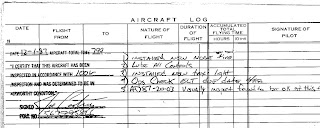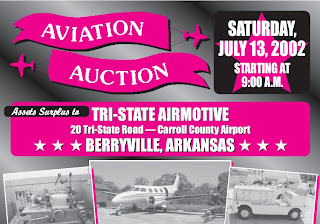
[
Beginning][
Previous Chapter]
In 1987, my son turned one year old. I was living in
Newton, MA (slogan:
The Garden City). This will be more interesting in a few minutes.
For details of what happened to 96934 between 12/31/1987 and 6/1/1993, I relied on the aircraft logbook, the ownership records at the FAA and information received from two individuals. It is a pretty sketchy picture.
The plane had routine maintenance performed on 12/1/1987. A tire and a light bulb were replaced, and some controls were lubed. The logbook notes that the TTAF (total time on airframe) was 799 hours. The next logbook entry is from 6/1/1993. At that time, there were 844 hours on the tach. It seems likely that many of those hours were logged by the pilot who flew the plane from sunny
Santa Ana, CA (slogan:
Downtown Orange County) to a snowbank in
Davenport, IA (slogan:
Crash Your Plane Here; actually,
Iowa's Front Porch!) by way of the East Coast. By that time, my son was almost seven and I was selling the house in Newton, on my way to
Antwerp, Belgium (slogan: '
t Stad is van iedereen; English:
the City is for everyone) for two years.

There are three entries with the 6/1/1993 date: one for a paint job, one for a new engine, and one containing the ever-so-benign text, "Replaced firewall - see 337 this date; installed customer supplied wings; rerigged all controls & test flown - OPS CK OK."
During that 5 1/2 years, the plane changed hands multiple times. As I mentioned in the last post, the owner sold it to the insurance company after the accident. They appear to have sold it to Midwest Air Center in
Mandan, ND (slogan:
Where the West Begins) in June of 1989. I have no information about Midwest Air Center, but they appear to still exist today. Whether the plane was ever dragged, carried, or otherwise transported to Mandan is a question mark, but common sense says it didn't get there. Six months later, in December, the plane was sold to El Paso Aircraft in
El Paso, TX (slogan:
The Land of the Sun). If you care enough to investigate on the internet, you will discover that El Paso didn't have an outstanding reputation. This is the first warning sign (unless you consider the total wreck of the plane in a remote airport) that there was trouble in store. In July, 1991, the plane was sold again to Lock Haven Aircraft Sales. Their business address was a post office box in
Wilmingon, DE (slogan:
A Place to be Someone). Given the inconvenience of storing planes in post office boxes, it is no surprise that this enterprise actually ran out of
Lock Haven, PA (no slogan found). From what I have learned, it was started by one of the partners in El Paso Aircraft. So even though the plane changed owners, it sort of stayed with the same owner. I still have no reason to believe that the plane had left Iowa by this time. My guess is that after doing whatever airplane traders do for nearly two years, Lock Haven finally got around to having the plane put back together. This was done by Larkin Floyd of Tri-State Airmotive in
Berryville, Arkansas (slogan:
Where History Meets Progress). On my maps, Arkansas is nowhere near Iowa, North Dakota, Texas or Pennsylvania. I'm thinking Larkin got the work based on price.

I had the opportunity to speak with Larkin in June of 2006, as I started learning about the plane I had bought and how different it was from the plane I had thought I bought. He is still running Tri-State, but it has apparently scaled way back from what it once was. Larkin told me that at that time he had a large staff. Now he is a one-man operation. I got some independent confirmation when I found this record of a big equipment
auction where he was scaling back his business in July of 2002.
In any case, Larkin was kind enough to go up into his old records for information about the work he had done on the plane. I was specifically looking for any documentation explaining the brief note, "customer-supplied wings." The need for that documentation will be revealed when we get to 2006. He didn't have any official paperwork, such as
yellow tags (tags indicating repairs done by an FAA authorized repair station--these are a very good thing to have) for the wings, but he did have some work orders that jogged his memory. He recalls having trouble getting the customer to pay for the work that was being done, which led to a stop-and-go nature on the project. According to him, he drove out to
Colorado (slogan:
Centennial State) to pick up these wings from a wing rebuilder named Coleman. He claims that Coleman was a real craftsman who had since passed away. $40,000 I no longer have and the expert opinion of some very qualified A & Ps make me think that he wasn't quite the craftsman Larkin claimed. Craftsman or not, Larkin bolted on the wings, repaired the firewall (first thing to break when a 182 has a rough landing), replaced the engine, and gave it a nice coat of paint.
With that chapter of its history over (or at least hidden), 96934 was sold to a private party in
Brookline, MA (traditional name:
Muddy River Hamlet ) on 7/20/1993. There is definitely kismet in play. Brookline is the next town over from Newton, and the plane arrived there four days before I left Newton on a migration that would take me two years later to Washington State, where the plane was first in service. Peeking ahead, that journey ends for plane and pilot in 1999, when we finally both arrive in California. That story will be revealed in another chapter.

